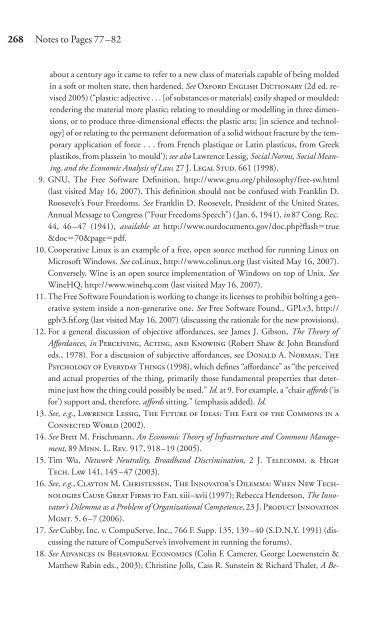Download - Future of the Internet â And how to stop it.
Download - Future of the Internet â And how to stop it.
Download - Future of the Internet â And how to stop it.
You also want an ePaper? Increase the reach of your titles
YUMPU automatically turns print PDFs into web optimized ePapers that Google loves.
268<br />
Notes <strong>to</strong> Pages 77–82<br />
about a century ago <strong>it</strong> came <strong>to</strong> refer <strong>to</strong> a new class <strong>of</strong> materials capable <strong>of</strong> being molded<br />
in a s<strong>of</strong>t or molten state, <strong>the</strong>n hardened. See OXFORD ENGLISH DICTIONARY (2d ed. revised<br />
2005) (“plastic: adjective . . . [<strong>of</strong> substances or materials] easily shaped or moulded:<br />
rendering <strong>the</strong> material more plastic; relating <strong>to</strong> moulding or modelling in three dimensions,<br />
or <strong>to</strong> produce three-dimensional effects: <strong>the</strong> plastic arts; [in science and technology]<br />
<strong>of</strong> or relating <strong>to</strong> <strong>the</strong> permanent deformation <strong>of</strong> a solid w<strong>it</strong>hout fracture by <strong>the</strong> temporary<br />
application <strong>of</strong> force . . . from French plastique or Latin plasticus, from Greek<br />
plastikos, from plassein ‘<strong>to</strong> mould’); see also Lawrence Lessig, Social Norms, Social Meaning,<br />
and <strong>the</strong> Economic Analysis <strong>of</strong> Law, 27 J. LEGAL STUD. 661 (1998).<br />
9. GNU, The Free S<strong>of</strong>tware Defin<strong>it</strong>ion, http://www.gnu.org/philosophy/free-sw.html<br />
(last vis<strong>it</strong>ed May 16, 2007). This defin<strong>it</strong>ion should not be confused w<strong>it</strong>h Franklin D.<br />
Roosevelt’s Four Freedoms. See Franklin D. Roosevelt, President <strong>of</strong> <strong>the</strong> Un<strong>it</strong>ed States,<br />
Annual Message <strong>to</strong> Congress (“Four Freedoms Speech”) (Jan. 6, 1941), in 87 Cong. Rec.<br />
44, 46–47 (1941), available at http://www.ourdocuments.gov/doc.phpflashtrue<br />
&doc70&pagepdf.<br />
10. Cooperative Linux is an example <strong>of</strong> a free, open source method for running Linux on<br />
Micros<strong>of</strong>t Windows. See coLinux, http://www.colinux.org (last vis<strong>it</strong>ed May 16, 2007).<br />
Conversely, Wine is an open source implementation <strong>of</strong> Windows on <strong>to</strong>p <strong>of</strong> Unix. See<br />
WineHQ, http://www.winehq.com (last vis<strong>it</strong>ed May 16, 2007).<br />
11. The Free S<strong>of</strong>tware Foundation is working <strong>to</strong> change <strong>it</strong>s licenses <strong>to</strong> prohib<strong>it</strong> bolting a generative<br />
system inside a non-generative one. See Free S<strong>of</strong>tware Found., GPLv3, http://<br />
gplv3.fsf.org (last vis<strong>it</strong>ed May 16, 2007) (discussing <strong>the</strong> rationale for <strong>the</strong> new provisions).<br />
12. For a general discussion <strong>of</strong> objective affordances, see James J. Gibson, The Theory <strong>of</strong><br />
Affordances, in PERCEIVING, ACTING, AND KNOWING (Robert Shaw & John Bransford<br />
eds., 1978). For a discussion <strong>of</strong> subjective affordances, see DONALD A. NORMAN, THE<br />
PSYCHOLOGY OF EVERYDAY THINGS (1998), which defines “affordance” as “<strong>the</strong> perceived<br />
and actual properties <strong>of</strong> <strong>the</strong> thing, primarily those fundamental properties that determine<br />
just <strong>how</strong> <strong>the</strong> thing could possibly be used.” Id. at 9. For example, a “chair affords (‘is<br />
for’) support and, <strong>the</strong>refore, affords s<strong>it</strong>ting.” (emphasis added). Id.<br />
13. See, e.g., LAWRENCE LESSIG, THE FUTURE OF IDEAS: THE FATE OF THE COMMONS IN A<br />
CONNECTED WORLD (2002).<br />
14. See Brett M. Frischmann, An Economic Theory <strong>of</strong> Infrastructure and Commons Management,<br />
89 MINN. L. REV. 917, 918–19 (2005).<br />
15. Tim Wu, Network Neutral<strong>it</strong>y, Broadband Discrimination, 2 J. TELECOMM. & HIGH<br />
TECH. LAW 141, 145–47 (2003).<br />
16. See, e.g., CLAYTON M. CHRISTENSEN, THE INNOVATOR’S DILEMMA: WHEN NEW TECH-<br />
NOLOGIES CAUSE GREAT FIRMS TO FAIL xiii–xvii (1997); Rebecca Henderson, The Innova<strong>to</strong>r’s<br />
Dilemma as a Problem <strong>of</strong> Organizational Competence, 23 J. PRODUCT INNOVATION<br />
MGMT. 5, 6–7 (2006).<br />
17. See Cubby, Inc. v. CompuServe, Inc., 766 F. Supp. 135, 139–40 (S.D.N.Y. 1991) (discussing<br />
<strong>the</strong> nature <strong>of</strong> CompuServe’s involvement in running <strong>the</strong> forums).<br />
18. See ADVANCES IN BEHAVIORAL ECONOMICS (Colin F. Camerer, George Loewenstein &<br />
Mat<strong>the</strong>w Rabin eds., 2003); Christine Jolls, Cass R. Sunstein & Richard Thaler, A Be-


